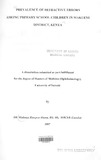| dc.contributor.author | Mulenga, Kangwa M | |
| dc.date.accessioned | 2013-05-25T08:12:58Z | |
| dc.date.available | 2013-05-25T08:12:58Z | |
| dc.date.issued | 2007 | |
| dc.identifier.citation | Degree of Masters of Medicine (Ophthalmology), University of Nairobi | en |
| dc.identifier.uri | http://erepository.uonbi.ac.ke:8080/xmlui/handle/11295/25603 | |
| dc.description | A dissertation submitted as part fulfillment
for the Degree of Masters of Medicine (Ophthalmology),
University of Nairobi | en |
| dc.description.abstract | Title:
Objective:
ABSTRACT:Prevalence of refractive errors among the primary school children of
Makueni District, Kenya.
To determine the magnitude and pattern of significant refractive errors in
primary school children in Kilungu division of Makueni District.
Methodology: A cross - sectional primary school based study of significant refractive
Results:
errors was conducted in Kilungu division of Makueni District on pupils
aged between 12 and 15 years old. All the pupils present during the time
of the study in the selected schools were included in the study .
Demographic data, history of ocular complaints and use of spectacles in
the family was obtained. Visual acuity was assessed from each pupil using
a Snellen's E chart. Ocular examination was carried out using a torch
and magnifying 20 Dioptre loupe. Significant refractive error was defined
VA of worse than 6118 and therefore objective refraction under cycloplegia
was carried out in all those pupils with visual acuity of worse than 6118
followed by subjective refraction. The type of refractive error after
refraction was grouped into hypermetropia, myopia or astigmatism.
1522 primary school pupils were eligible to participate in the study, but
1439 pupils (94.5%) were screened for refractive errors and 83 pupils
(5.5%) were absent. The response rate was high at 94.5%.
The females contributed 59.2% and the males 40.8%. There was no
statistical difference between the sexes, p =0.453. The mean age of those
was 13.28 years with standard deviation of 1.10 years and the median was
13.0 years. The prevalence of significant refractive error was 5.2%
(75/1439), being responsible for 92.6 % of all causes of poor eyesight.
Hypermetropia accounted for 3.2%, myopia 1.7% and astigmatism 0.3%
of refractive errors. Myopia was more likely to be present in the pupils
aged 14 to 15 years than those aged 12 to 13 years with OR 0.3 which was
statistically significant (p = 0.022).
Conclusion: The overall prevalence of significant refractive errors (VA worse than
6/18) in pupils aged 12 to 15 years in Makueni's Kilungu division was
5.2%. A regular school screening programme would be beneficial to the
primary schools in this area. Hypermetropia was the most prevalent
refractive error at 3.2% followed by myopia at 1.7% and astigmatism at
0.3%. | en |
| dc.language.iso | en | en |
| dc.publisher | University of Nairobi | en |
| dc.title | Prevalence of refractive errors among primary school children in Makueni District, Kenya | en |
| dc.type | Thesis | en |
| dc.description.department | a
Department of Psychiatry, University of Nairobi, ; bDepartment of Mental Health, School of Medicine,
Moi University, Eldoret, Kenya | |
| local.publisher | School of Medicine | en |

